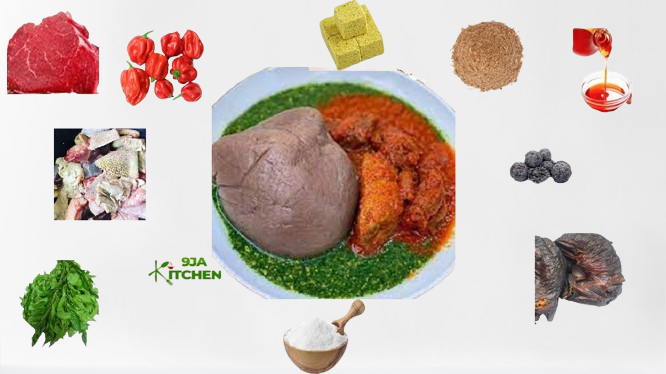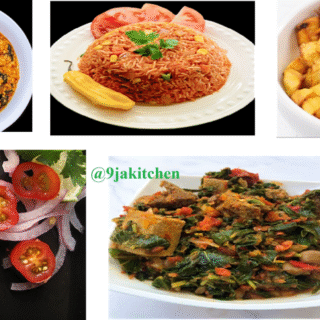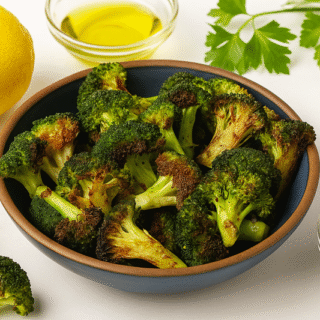Introducing Ewedu Soup
Ewedu soup is a traditional Yoruba dish popular in Nigeria, renowned for its nutritious qualities and unique, viscous texture. The soup is made from the leaves of the jute plant, which are rich in vitamins and minerals. Here, we will look at a detailed guide on how to prepare ewedu soup, along with some tips on serving and customisation to suit your taste preferences.
If you live outside of Nigeria, you might want to explore some easy Nigerian dishes you can make. Finding all the ingredients for a dish like ewedu can be challenging, depending on your location, unless you know where to look for them.
Table of Contents
Ingredients
- Fresh Ewedu Leaves: 2 bundles (or you can use frozen ewedu if fresh is not available)
- Water: Approximately 4 cups
- Iru (Locust Bean): 1-2 tablespoons (optional, for a richer flavour)
- Ground Crayfish: 2 tablespoons
- Pepper: 1-2 Scotch bonnets or habanero peppers (to taste)
- Palm Oil: 1/2 cup (this adds richness and flavour)
- Meat/Fish: You can use assorted meats, goat meat, beef, or dried fish (optional)
- Salt: To taste
- Seasoning Cubes: 1-2 cubes (optional)
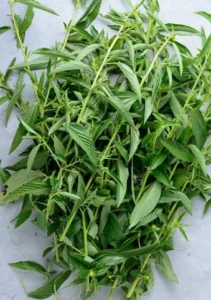
Ewedu (Juta mallow) leaf
Equipment Needed
- Large Pot: For cooking the soup
- Blender: For pureeing the leaves and other ingredients (optional; you can also chop by hand)
- Mortar and Pestle: For grinding pepper and iru (optional)
- Cooking Spoon: For stirring
Instructions
Step 1: Prepare the Ewedu Leaves
- Washing: If you’re using fresh ewedu leaves, rinse them thoroughly in cold water to remove any dirt or grit. Be sure to pick out any damaged or wilted leaves.
- Chopping: You can chop the leaves finely with a knife or use a blender to puree them. If you prefer a smoother texture, blending is the way to go. If you enjoy a bit of texture, chopping is suitable.
Step 2: Cooking the Meat
- If using meat, place it in a pot and add water to cover. Season with salt and a cube of seasoning. If you like, you can add onion slices and other spices to enhance the flavour.
- Boil the meat until tender. This can take about 30-45 minutes, depending on the type of meat used.
- Once the meat is cooked, you can reserve some of the stock for later use in the soup.
Step 3: Making the Soup
- In another pot, bring about 4 cups of water to a boil.
- Add the chopped or blended leaves to the boiling water. Stir continuously to avoid lumps forming. Allow it to cook for about 10-15 minutes on medium heat. The leaves will soften, and the soup will become viscous.
- Stir in the iru (if using), ground crayfish, and chopped pepper. Adjust the seasoning by adding salt or seasoning cubes to taste. If you like a bit of an extra kick, you can add more pepper.
- Add the palm oil and let it simmer for an additional 5-10 minutes. The palm oil will give the soup its rich flavour and colour.
Step 4: Final Touches
- If you reserve meat stock earlier, you can incorporate it into the soup to enhance the taste.
- Ensure everything is thoroughly mixed, and adjust the consistency by adding more water if it seems too thick.
- Taste and adjust seasoning as necessary.
Serving Suggestions
The soup is best served with accompaniments such as pounded yam, amala, or fufu, which can be used to scoop up the soup. It can also be paired with rice or served as a side dish. Some people enjoy adding a protein source, such as fried chicken or fish, to their meals.
Tips for Customisation
- Vegetarian Option: You can make a vegetarian version by omitting meat and using mushrooms for flavour.
- Hicker Consistency: For a thicker soup, reduce the amount of water you add initially or allow the soup to simmer longer.
- Flavour Enhancements: You can add spices like thyme or bay leaves during the meat cooking phase for added flavour.
Ewedu soup is not only delicious but also a great source of nutrients. It’s a vibrant dish that showcases the rich culinary traditions of Nigeria. Enjoy your cooking!
Ewedu Soup Recipe
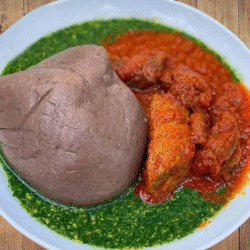
Ewedu Soup Recipe
Equipment
- 1 Large Pot: For cooking the soup
- 1 Blender: For pureeing the leaves and other ingredients (optional); you can also chop by hand.
- 1 Mortar and Pestle: For grinding pepper and iru (optional)
- 1 Cooking Spoon: For stirring
Ingredients
- Fresh Ewedu Leaves: 2 bundles (or you can use frozen ewedu if fresh is not available)
- 4 cups Water
- 1-2 tbsp Iru (Locust Bean) optional, for a richer flavour
- 2 tbsp Ground Crayfish
- Pepper: 1-2 Scotch bonnets or habanero peppers (to taste)
- 1/2 cup Palm Oil (this adds richness and flavour)
- Meat/Fish: You can use assorted meats, goat meat, beef, or dried fish (optional)
- Salt: To taste
- 1-2 Cubes Seasoning Cubes: 1-2 cubes (optional)
Instructions
Step 1: Prepare the Ewedu Leaves
- Washing: If you’re using fresh ewedu leaves, rinse them thoroughly in cold water to remove any dirt or grit. Be sure to pick out any damaged or wilted leaves.
- Chopping: You can chop the leaves finely with a knife or use a blender to puree them. If you prefer a smoother texture, blending is the way to go. If you enjoy a bit of texture, chopping is suitable.
Step 2: Cooking the Meat
- If using meat, place it in a pot and add water to cover. Season with salt and a cube of seasoning. If you like, you can add onion slices and other spices to enhance the flavour.
- Boil the meat until tender. This can take about 30-45 minutes, depending on the type of meat used.
- Once the meat is cooked, you can reserve some of the stock for later use in the soup.
Step 3: Making the Soup
- In another pot, bring about 4 cups of water to a boil.
- Add the chopped or blended ewedu leaves to the boiling water. Stir continuously to avoid lumps forming. Allow it to cook for about 10-15 minutes on medium heat. The leaves will soften, and the soup will become viscous.
- Stir in the iru (if using), ground crayfish, and chopped pepper. Adjust the seasoning by adding salt or seasoning cubes to taste. If you like a bit of an extra kick, you can add more pepper.
- Add the palm oil and let it simmer for an additional 5-10 minutes. The palm oil will give the soup its rich flavour and colour.
Step 4: Final Touches
- If you reserved meat stock earlier, you can incorporate it into the soup to enhance the taste.
- Ensure everything is thoroughly mixed, and adjust the consistency by adding more water if it seems too thick.
- Taste and adjust seasoning as necessary.
Notes
Serving Suggestions
Ewedu soup is best served with swallows such as pounded yam, amala, or fufu, which you can use to scoop up the soup. It can also be paired with rice or served as a side dish. Some people enjoy adding a protein like fried chicken or fish alongside their meal.Tips for Customisation
- Vegetarian Option: You can make a vegetarian version by omitting meat and using mushrooms for flavour.
- Hicker Consistency: For a thicker soup, reduce the amount of water you add initially or allow the soup to simmer longer.
- Flavour Enhancements: You can add spices like thyme or bay leaves during the meat cooking phase for added flavour.
Health Benefits of Ewedu Soup
- Nutrient-Rich: Ewedu, also known as jute leaves, is packed with essential vitamins and minerals, including vitamins A, C, and E, as well as calcium, iron, and fibre, which support overall health↗.
- Digestive Health: The high fiber content in ewedu helps promote healthy digestion, prevents constipation, and supports gut health.
- Antioxidant Properties: Ewedu is rich in antioxidants, which can help combat oxidative stress and reduce the risk of chronic diseases.
- Anti-Inflammatory Effects: The leaves possess anti-inflammatory properties that may help alleviate inflammation in the body↗, potentially benefiting conditions such as arthritis.
- Weight Management: It is low in calories but high in nutrients, making it a great addition to a weight management plan, providing satiety without excess calories.
- Hydration: The soup has a high water content, contributing to hydration, which is crucial for bodily functions.
- Blood Sugar Regulation: Some studies suggest that ewedu may help in regulating blood sugar levels, making it a good option for diabetics.
Health Challenges
- Allergic Reactions: Some individuals may experience allergies to jute leaves, resulting in symptoms such as skin irritation or digestive upset.
- Oxalate Content: Ewedu leaves contain oxalates, which can interfere with calcium absorption and may contribute to the formation of kidney stones in susceptible individuals if consumed in excess.
- Preparation Method: If not properly prepared or stored, ewedu soup can become a breeding ground for bacteria, leading to foodborne illnesses↗.
- Nutrient Imbalance: Relying too heavily on ewedu soup without a balanced diet may lead to nutrient imbalances, as it’s important to incorporate a variety of foods for optimal health.
- Cultural Sensitivities: In some regions, ewedu may not be widely accepted or may be seen as an acquired taste, which could limit its consumption and associated benefits.
In conclusion, while ewedu soup offers numerous health benefits, it’s essential to consume it as part of a balanced diet and remain mindful of any potential health challenges.
Nutritional Composition↗
-
Vitamins:
- Vitamin A: Ewedu leaves are rich in beta-carotene, which the body converts to vitamin A, essential for vision and immune function.
- Vitamin C: Supports the immune system and acts as an antioxidant.
- B vitamins, including folate, which is important for cellular function and tissue growth.
-
Minerals:
- Calcium: Important for bone health.
- Iron: Necessary for the production of red blood cells and helps prevent anaemia.
- Magnesium: Supports muscle and nerve function and bone health.
-
Fiber:
- Ewedu is high in dietary fiber, which aids digestion and helps maintain a healthy gut.
-
Protein:
- Although it is primarily a vegetable dish, ewedu contributes some protein, especially when paired with other ingredients like meat or fish in soups.
-
Antioxidants:
- Contains various antioxidants that can help protect the body from oxidative stress.
- 🍓🍞 How To Make berry bread loaf – A Deliciously Foolproof Homemade Favorite
- How To Make Berry Syrup – A Powerful, Delightful Homemade Sweetener You’ll Love🍓❤️
- 🍓 How To Make Berry Infused Water: A Refreshing Ultimate Hydration Drink
- How To Make Mixed Berry Jam: A Powerful, Joy-Filled Homemade Favorite 🍓✨
- 🍇 How To Make Irresistible Blueberry Compote At Home (A Powerfully Delicious Recipe)

Did you make this recipe? Please do leave a comment and rating on the blog. Tag us your picture on Instagram @real9jakitchen

